Content for TS 23.282 Word version: 19.3.0
1…
5…
6…
6.6…
7…
7.4…
7.4.2.1.10…
7.4.2.2…
7.4.2.5…
7.4.2.8…
7.4.3…
7.5…
7.5.2.1.12…
7.5.2.2…
7.5.2.4…
7.5.2.6…
7.5.2.8…
7.5.2.11…
7.5.2.14…
7.5.3…
7.6
7.7…
7.7.2.1.13…
7.7.2.2…
7.8…
7.9…
7.13…
7.13.3.1.19…
7.13.3.2…
7.13.3.8…
7.13.3.16…
7.13.4…
7.14…
7.14.2.2…
7.17…
7.17.2.13…
7.17.3…
7.17.3.1.4…
7.17.3.2…
7.17.3.2.4…
7.17.3.2.6…
7.17.4…
7.17.6…
7.17.7…
A…
B…
7.5.2.2 File upload using HTTP
7.5.2.2.1 General
7.5.2.2.2 Procedure for uploading the file residing in the local storage of the MCData UE without QoS
7.5.2.2.3 Procedure for uploading the file residing in the MCData message store
7.5.2.2.4 Procedure for file upload including request of network resources with required QoS
7.5.2.3 File download using HTTP
7.5.2.3.1 General
7.5.2.3.2 Procedure for file download from the MCData content server without QoS
7.5.2.3.3 Procedure for file download including request of network resources with required QoS
...
...
7.5.2.2 File upload using HTTP p. 110
7.5.2.2.1 General p. 110
The media storage client uses HTTP for a standalone data file upload towards the MCData content server.
7.5.2.2.2 Procedure for uploading the file residing in the local storage of the MCData UE without QoS p. 111
The procedure in Figure 7.5.2.2.2-1 describes the case where an MCData user is uploading a file to media storage function on the MCData content server.
Pre-conditions:
- The MCData user on the media storage client is registered for receiving MCData service.
- The MCData content server has the ability to verify if the requesting MCData user is authorised to upload.
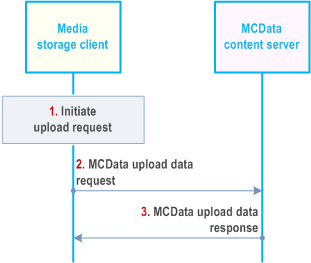
Step 1.
The user at the media storage client initiates a file upload request of the chosen file. If MCData emergency state is already set for the media storage client (due to previously triggered MCData emergency alert), the media storage client sets emergency indicator in the request. The media storage client verifies that the size of the file is within the maximum data size for FD for the intended MCData FD request (by checking the group configuration for a group FD request and by checking the service configuration for a one-to-one FD request).
Step 2.
The file to be uploaded is received by the media storage client and sent to the media storage function on the MCData content server for storing using the MCData upload data request.
Step 3.
The MCData content server stores the file and provides a MCData upload data response indicating success (along with file URL to the media storage client) or failure.
7.5.2.2.3 Procedure for uploading the file residing in the MCData message store |R17| p. 111
The procedure in Figure 7.5.2.2.3-1 describes the case where an MCData user is uploading a file to media storage function on the MCData content server from his or her MCData message store account.
Pre-conditions:
- The Media storage client knows the URL of the file residing in the MCData message store account of the user.
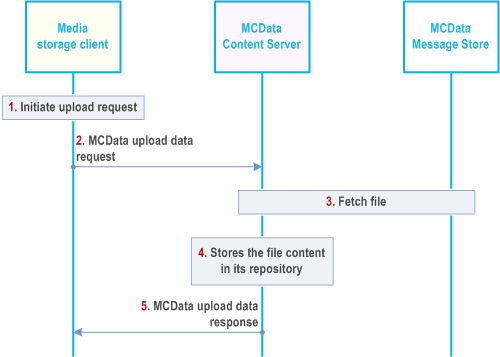
Step 1.
The user at the media storage client initiates a file upload request of the file residing in his MCData message store account.
Step 2.
The URL of the file which needs to be retrieved from the MCData message store account of the user is sent to the media storage function on the MCData content server using the MCData upload data request.
Step 3.
The MCData content server fetches the file from the MCData message store account of the user using the URL provided in the MCData upload data request.
Step 4.
The MCData content server stores the retrieved file content into its repository.
Step 5.
The MCData content provides a MCData upload data response indicating success (along with file URL to the media storage client) or failure.
7.5.2.2.4 Procedure for file upload including request of network resources with required QoS |R17| p. 112
The procedure in Figure 7.5.2.2.4-1 describes the case where an MCData client sends a request to the MCData server for the upload of a file from the media storage client on the MCData client to the media storage function on the MCData content server. The MCData server can, therefore, request network resources with the required QoS for the corresponding file upload.
Pre-conditions:
- The MCData user on the MCData client is registered on the MCData server for receiving MCData service.
- The MCData client is required to upload a file to the MCData content server over network resources with required QoS.
- The MCData client knows its IP address/port to be used for the file upload as well as the URI or IP address/port of the target MCData content server.
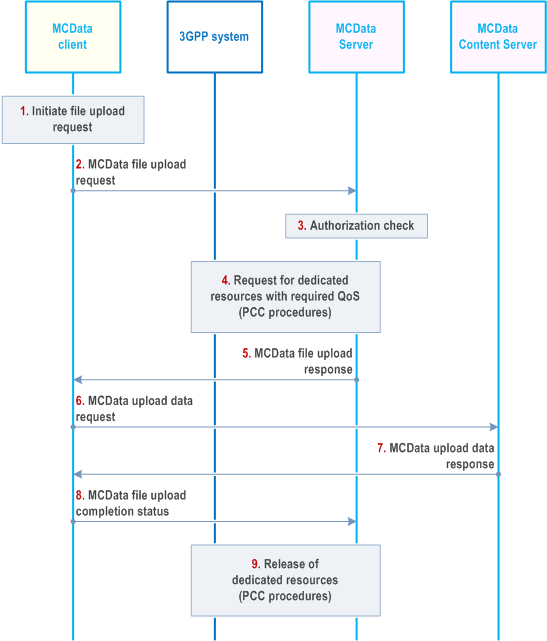
Step 1.
The MC user on the MCData client intends to upload a file to the MCData content server for file distribution. The MCData client verifies that the size of the file is within the maximum data size for FD for the intended MCData FD request (e.g., by checking the group configuration for a group FD request or the service configuration for a one-to-one FD request). If the MCData emergency state is already set for the MCData client, the MCData client sets the emergency indicator in the request.
Step 2.
The MCData client sends the MCData file upload request to the MCData server. This request contains information about the MCData client (including IP address and port to be used for the file upload), and the target MCData content server (including associated URI or IP address, and port).
Step 3.
The MCData server verifies that the corresponding MCData client is authorized to upload files to the corresponding MCData content server.
Step 4.
If the MCData client is authorized for the file upload, the MCData server sends a request to the 3GPP system for the allocation of network resources with the required QoS for the corresponding file upload communication between the MCData client and the MCData content server. For that, the MCData server performs policy and charging control (PCC) procedures, e.g., over the Rx reference point as described in TS 23.203 for the case of an EPS system.
Step 5.
The MCData server sends a MCData file upload response to the MCData client indicating if it can proceed with the file upload to the MCData content server.
Step 6.
The media storage client on the MCData client sends an MCData upload data request to the media storage function on the MCData content server to upload the file.
Step 7.
The MCData content server provides an MCData upload data response to the MCData client indicating if the file was successfully stored (along with file URL) or failure.
Step 8.
The MCData client provides to the MCData server an MCData file upload completion status indicating that the file upload is completed.
Step 9.
Based on the MCData file upload completion status, the MCData server requests to the 3GPP system to release the network resources allocated for the corresponding file upload.
7.5.2.3 File download using HTTP p. 114
7.5.2.3.1 General p. 114
The media storage client uses HTTP for a standalone data file download from the MCData content server.
7.5.2.3.2 Procedure for file download from the MCData content server without QoS p. 114
The procedure in Figure 7.5.2.3.2-1 describes the case where an MCData user is downloading a file from the media storage function of the MCData content server.
Pre-conditions:
- The MCData user on the media storage client is registered for receiving MCData service.
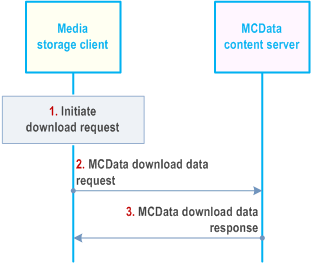
Step 1.
The user at the media storage client initiates a file download request available at the indicated URL.
Step 2.
The file available at the URL (received in MCData FD request or MCData group standalone FD request) is requested to be downloaded by the media storage client from the media storage function on the MCData content server using a MCData download data request. If emergency indicator is set in received in MCData FD request or MCData group standalone FD request, the media storage client sets emergency indicator in MCData download data request.
Step 3.
The media storage function on the MCData content server may apply reception control policy and provides a MCData download data response including the file to the media storage client.
7.5.2.3.3 Procedure for file download including request of network resources with required QoS |R17| p. 114
The procedure in Figure 7.5.2.3.3-1 describes the case where an MCData client sends a request to the MCData server for the download of a file from the media storage client on the MCData client to the media storage function on the MCData content server. The MCData server can, therefore, request network resources with the required QoS for the corresponding file download.
Pre-conditions:
- The MCData user on the MCData client is registered on the MCData server for receiving MCData service.
- The MCData client has been requested to download a file using HTTP and has received the corresponding file URL (via an MCData FD request or MCData group standalone FD request).
- The MCData client is required to download a file from the MCData content server over network resources with required QoS.
- The MCData client knows its IP address/port to be used for the file download as well as the URI or IP address/port of the target MCData content server.
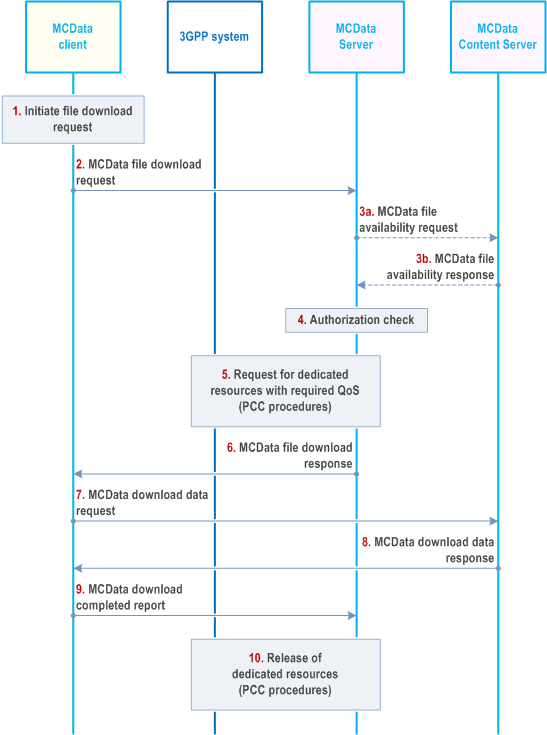
Step 1.
The MC user on the MCData client intends to download a file from the MCData content server based on a received MCData FD request or MCData group standalone FD request. If the MCData emergency state is already set for the MCData client, the MCData client sets the emergency indicator in the request.
Step 2.
The MCData client sends the MCData file download request to the MCData server. This request contains information about the MCData client (including IP address and port to be used for the file download), and the target MCData content server (including associated URI or IP address, and port). The request also contains the corresponding file URL on the MCData content server.
Step 3.
The MCData server may verify, based on the received file URL, whether the file is available in the MCData content server via the MCData-FD-5 reference point. For that, the MCData server sends an MCData file availability request to the MCData content server. Upon the receipt of the request, the MCData content server provides an MCData file availability response to the MCData server. If the MCData server identifies that the corresponding file is not available in the MCData content server, the MCData server provides a response to the MCData client indicating that the file download request cannot proceed due to the unavailability of the file in the MCData content server.
Step 4.
The MCData server verifies that the corresponding MCData client is authorized to download the file from the corresponding MCData content server.
Step 5.
If the MCData client is authorized for the file download, the MCData server sends a request to the 3GPP system for the allocation of network resources with the required QoS for the corresponding file download communication between the MCData client and the MCData content server. For that, the MCData server performs policy and charging control (PCC) procedures, e.g., over the Rx reference point as described in TS 23.203 for the case of an EPS system.
Step 6.
The MCData server sends a MCData file download response to the MCData client indicating whether it can proceed with the file download from the MCData content server.
Step 7.
The media storage client on the MCData client sends an MCData download data request to the media storage function on the MCData content server to download the corresponding file.
Step 8.
The MCData content server provides an MCData download data response to the MCData client including the file for the case of a successful response.
Step 9.
The MCData client provides to the MCData server an MCData download completed report indicating that the file download is completed.
Step 10.
Based on the MCData download completed report, the MCData server requests to the 3GPP system to release the network resources allocated for the corresponding file download.